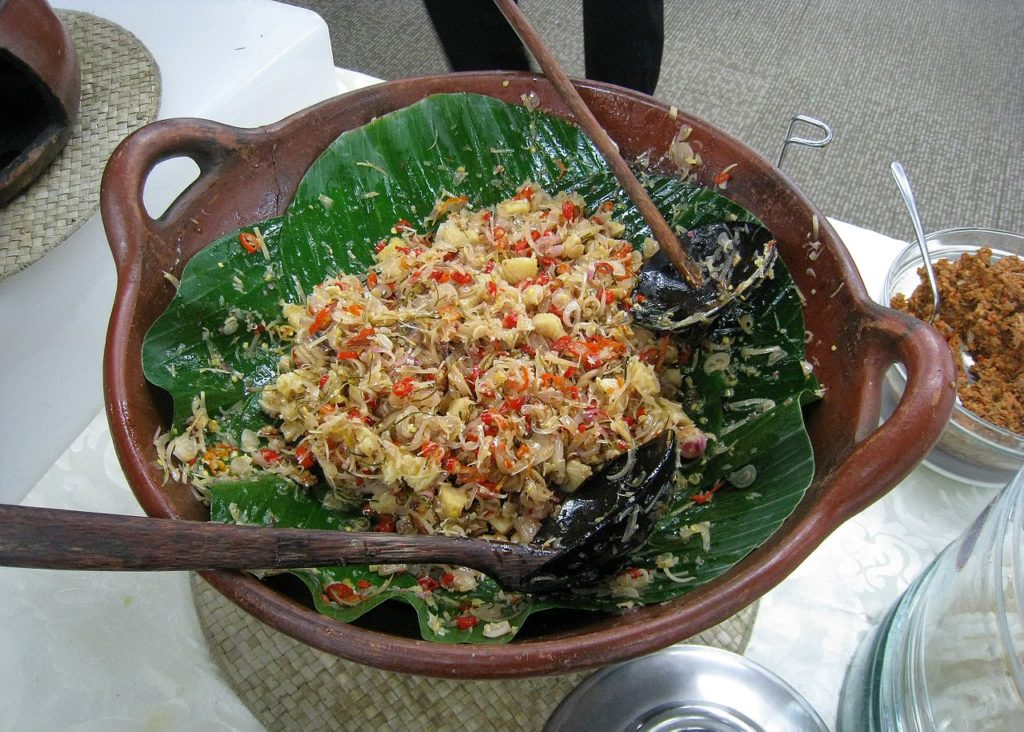Banana ketchup, Philippines
We are all familiar with tomato ketchup, used as a dip or sauce for everything from French fries to hot dogs. The Filipino version, however, is made from bananas.
During World War II, tomatoes were scarce in the Philippines, so food technician Maria Orosa came up with the idea of replacing tomatoes with bananas, adding red food colouring to make the brown-hued ketchup more appealing.
 Sweeter and less tangy than its tomato counterpart, banana ketchup is an ideal accompaniment to crispy lechon kawali (deep-fried pork belly), sinangag (garlic fried rice) and smoky tortang talong (eggplant omelette).
Sweeter and less tangy than its tomato counterpart, banana ketchup is an ideal accompaniment to crispy lechon kawali (deep-fried pork belly), sinangag (garlic fried rice) and smoky tortang talong (eggplant omelette).
It also features prominently in Filipino spaghetti, where it is ladled over the pasta in place of bolognese sauce.
While bottled banana ketchup is widely available, you can make your own at home by simmering mashed banana with garlic, ginger, onions, bell peppers, chillies, vinegar, salt, paprika, cinnamon powder, crushed cloves and brown sugar. Some recipes even call for a splash of rum.
Kapeek, Cambodia
Cambodian cuisine features an extensive use of three fermented products – prahok and touk trey, both variations of fish sauce, and kapeek (shrimp paste).
Among the three, kapeek is most frequently used for spicy relishes and the most common offering is kapeek pow, made by pounding shrimp paste together with dried shrimp, garlic, chillies, sugar, tamarind and peanuts with a mortar and pestle.
Kapeek pow is typically served as a dip for raw and crunchy vegetables like long beans, cucumbers and eggplants, and even unripe mangoes.
Similar products are known as kapi in Thailand, bagoong in the Philippines, belacan in Malaysia, mam tom in Vietnam, ngapi in Myanmar and terasi in Indonesia.
Nuoc mam pha, Vietnam
A quintessential Vietnamese condiment, nuoc mam pha is served with almost everything, from noodles like bun cha to spring rolls.
At its simplest, it is a blend of nuoc mam (fish sauce), lime juice, sugar, garlic and chilli slices.
 Mainly used as a dipping sauce, nuoc mam pha balances spicy, sweet and sour notes, and adds a distinctive briny flavour, courtesy of the fish sauce.
Mainly used as a dipping sauce, nuoc mam pha balances spicy, sweet and sour notes, and adds a distinctive briny flavour, courtesy of the fish sauce.
It can also be used in cooking as a marinade for thit heo nuong xa (lemongrass pork chop) or gan ga chien nuoc mam (stir-fried chicken tendon).
A staple of every Vietnamese kitchen, this sauce is usually made in big batches and stored in jars. It can be kept in the fridge for up to two weeks.
Jaew bong, Laos
Jaew bong is a sweet, spicy relish that complements sticky rice, grilled meats and parboiled vegetables with its bold flavour.
Traditionally, roasted chillies are ground using a pestle and mortar along with ingredients like shallots, garlic, galangal, palm sugar, tamarind juice, fish sauce and salt.
 What makes jaew bong special is the addition of thin, chewy slivers of water buffalo or pork skin, which get pounded into the mix.
What makes jaew bong special is the addition of thin, chewy slivers of water buffalo or pork skin, which get pounded into the mix.
Laotians especially love to have jaew bong as a dip for kaipen, a crispy snack made from riverweed harvested from the Mekong River.
Aside from Laos, jaew bong can also be found in northeastern Thailand.
Sambal matah, Indonesia
Indonesians are crazy about their sambal, a spicy relish made with chillies and other ingredients.
Sambal is commonly seen as a dip for lalapan, a side dish consisting of several kinds of fresh, blanched and boiled vegetables.
There are hundreds of types of sambal in Indonesia, with each region having its own specialty. In Bali, sambal matah reigns supreme.
 This citrusy, umami-packed condiment is made with finely sliced chillies, shallots, tomatoes, lemongrass, kaffir lime leaves and torch ginger, along with shrimp paste, lime juice and vegetable oil.
This citrusy, umami-packed condiment is made with finely sliced chillies, shallots, tomatoes, lemongrass, kaffir lime leaves and torch ginger, along with shrimp paste, lime juice and vegetable oil.
Some recipes call for a little hot oil to be added to the raw ingredients to lightly cook them, sometimes after first frying the lemongrass in it for a more intense flavour.
Traditionally, sambal matah is served as a dipping sauce, adding its spicy, fresh and bright flavours to dishes like bebek tutu (roast duck) and sate lilit (minced meat satay).
But due to its popularity across Indonesia, it has also been incorporated into other local dishes like Rote’s se’i (smoked pork) and Javanese ayam geprek (smashed crispy fried chicken), and even non-Indonesian dishes like spaghetti and chicken katsu (Japanese-style chicken cutlet).
According to airasia.com













